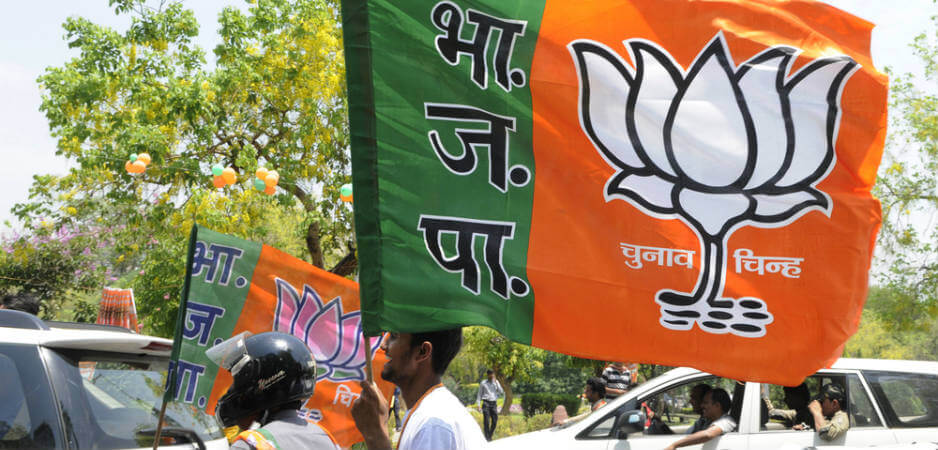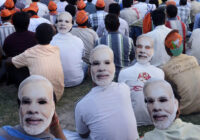The movement to change India’s national symbolism under the BJP deliberately targets the principal ideas underpinning the vision of India as a secular state.
On October 16, 2018, Yogi Adityanath, the chief minister of Uttar Pradesh and well known Bharatiya Janata Party (BJP) Hindu-right hardliner, announced a change of name of one of north India’s most historically important cities (and its associated district) — Allahabad. The new city, henceforth, is to be officially known as Prayagraj, a name that connects to Prayag, meaning “place of offerings,” and reflecting the significance of the city in Hindu mythology as the point of the confluence (sangam) of three rivers — the Ganga, Yamuna and the mythical Sarasvati.
The attempt to erase aspects of India’s Indo-Islamic culture here is clear: Allahabad had become a city of political and administrative importance through the 17th century, following the siting of a fort there by Emperor Akbar in 1584 and its foundation as a large imperial city under the name of Allahabas. The grandson of Akbar, Shah Jahan, subsequently named the city Allahabad following his accession to the Mughal throne in 1628.
The city was home to both the most important of the country’s high courts and was pivotal in the development of India’s anti-colonial nationalist leadership, being home to the Nehru family. The city’s constituencies had, through the 1950s and 1970s, supported Nehru and his Congress Party associates. Socialism had also been strong in the city, which was the home of Ram Mohan Lohia. In social terms, Allahabad’s elite has been pivotal in India’s modern political history, being largely dominated by three powerful Kashmiri families — Nehru, Katju and Sapru — and boasting one of the most historically important university student unions.
The name change, then, is clearly part of a large scale and more systematic process of political iconoclasm that has a range of implications for the Sangh Parivar’s (the family of Hindu right-wing organizations) self-projection. In the case of Allahabad, the name change has proximate and more profound aspects. On the one hand, for the Rashtriya Swayamsevak Sangh (RSS, a right-wing volunteer movement associated with the BJP), the city was important as a base for some of the organization’s key leaders in last part of the 20 century; the name Prayag is routinely used by the RSS. The city is also the location for one of the most important large-scale festivals of the Hindu calendar, the Kumbh Mela, which takes place every 12 years. And, importantly, the city’s existing name itself is associated with the Muslim minority in India.
Political Iconoclasm
In the short term, Adityanath’s move seems to have backfired, as social media is flooded with memes ridiculing the chief minister’s petulance in renaming places to make them sound more Hindu. The renaming of Allahabad, however, points to more profound changes: the unraveling of some of the principal national symbols in a manner which signals a deliberate attempt to transform historical consciousness and shape new ideas of national belonging. In some cases this is more appropriation than deletion.
The most spectacular initiative in the former category has been the projected giant iron statue of Vallabhai Patel, the so-called “Iron Man” of India and its first home minister. Patel has been repeatedly evoked by the Hindu right as a conservative Congress leader sympathetic to many of its ideas. A Gujarati, like Prime Minister Narendra Modi, Patel’s immortalization as the world’s largest statue reflects the gigantism of India’s new regime, from the exaggerated projections of the so-called Gujarat model of economic development to the popular circulation of Modi’s 56-inch chest as a prerequisite for the achievement.
The giant statue is planned to oversee the massive dam project at Sardar Sarovar, which has also seen the displacement of a number of Tadvi tribal villages and their religious sites (Sadhu Tekri). Protests against this state gigantism and its use of national icons has come, over the medium to longer term, from celebrities including Arundhati Roy and Aamir Khan, and especially the Narmada Bachao Andolan — an Adivasi movement that has coopted human rights activists.
Adityanath, then, is following a well developed trend in his naming campaign, which goes right back to the deliberate attacks on established nationalist legacies in India from the beginning of BJP rule. Modi’s 2014 election tour, particularly toward the end of the campaign, illustrated, for example, the enormity of the post-independence era for the symbolic construction of state development and national freedom, and the potential desire to rethink its significance for a putative new regime.
The BJP made as much mileage as possible out of dissatisfaction with the long-standing dynastic politics of the Nehru family. In one of Modi’s speeches in Amethi in Uttar Pradesh in May, for example, the sound bites were clear: “India is done with this [Nehru-Gandhi] dynasty. India has had them for over 60 years. It’s time for the poor and the dispossessed to rise to the top … the government of mother and son is about to go, nothing can stop it now.” The most direct and salacious attack of all was a poster containing an image of Jawaharlal Nehru and Edwina Mountbatten (wife of Britain’s last viceroy of India) alongside the words “Deshi Videshi patni premi” (native foreign-wife lovers), versus Modi as “Desh premi” (country lovers), making a reference to the alleged love affair between Nehru and Edwina.
Rhetoric about the end of a dynasty automatically evoked the idea of the end of an era, and a movement away from autocracy to democracy, quickly reflecting the idea of the end of princes’ rule over most of India shortly following 1947. Key to Modi’s symbolic approach and attack on Nehru was to connect himself as directly as possible to the historical drama of Nehru’s conflict with Vallabhai Patel. Again, in the first week of May in a speech at Ambedkar Nagar, he argued counterfactually that “if Sardar Patel had become the first prime minister things would have been very different… This family did not do justice with him. I have come from Patel’s state.” Personal hubris and historical identification also played its part.
Deliberate Obliteration
Since the election of Narendra Modi in 2014, a range of other central government projects have been renamed or rebranded, in most cases with a drive to remove associations with the Nehruvian legacy. Movement between different types of historical figures has allowed the BJP to be iconoclastic in some areas too, especially around Congress’s key anniversaries and hagiographies. October 31 — Patel’s birthday — has been renamed Unity Day and the celebrations are to be televised by Doordarshan from Patel’s home village of Karamsad, in Gujarat. This was a deliberate obliteration of the use of the date to commemorate the anniversary of Indira Gandhi’s death.
The Modi regime has sought to place it’s own man — Deen Dayal Upadhayaya — as the symbolic center of movements for rural reform and tribal development. It did so by relaunching and renaming an older rural skills program after the ideologue. Similarly, a decision was made to drop the name Nehru from the Jawaharlal Nehru National Urban Renewal Mission, and Indira Awaas Yojna, the rural housing scheme, was slated as being changed to National Gramin Awaas Mission.
Renaming development and education programs is not simply an exercise in re-signification. It is a process, too, of establishing a new intellectual and cultural milieu that is distinctively Indian by virtue of its historical depth as “prior” to the West. Key here is the idea of India’s “ancient” (and therefore “prior” or “superior”) culture as a means of rejuvenating the idea of the Indian nation in contemporary India. Two recent events serve as examples. The head of the Indian Council for Historical Research, Professor Yellapragada Sudershan Rao, has as his main agenda, — a drive to “prove the historicity of the [Indian epics] Mahabharata and Ramayana.” In even more bizarre fashion, Anand J. Bodas, an attendee of the Indian Science Congress, claimed that the first human flight technologies had taken place at the time of the Vedas.
 This has been a longer-term approach of the BJP. In the 1980s the party strongly supported the decision by Doordarshan, the Indian television broadcaster, to televise versions of the Indian epics like the Mahabharata and Ramayana.
This has been a longer-term approach of the BJP. In the 1980s the party strongly supported the decision by Doordarshan, the Indian television broadcaster, to televise versions of the Indian epics like the Mahabharata and Ramayana.
All post-colonial regimes go through phases of symbolic rejuvenation, and these iconoclastic initiatives in some ways reflect the earlier removal of colonial era statues and names. One of the key differences is that in the 1950s, much of the initiative in this area came from the grassroots, whereas the Hindu right’s iconoclasm and renaming is state-driven. On May 14,1957 — the centenary of the Indian Mutiny — the national parliament debated the removal or change of colonial era statues. Few powerful voices argued that monuments from the British period were “offensive.” In fact, many MPs were in favor of restoring and maintaining them.
All the same, in a number of cases statues, monuments and cemeteries were desecrated, defaced, destroyed or removed by crowds and popular movements. There were also agitations to have statues of Queen Victoria removed in various places, including one in front of the Council Hall in Bombay. Other memorials faced more direct popular reaction. Cemeteries became particular targets. By April 1,1948, over 800 had been taken over across India, and there were reports of desecration of the sites, especially when they were located in remote areas.
The movement to change India’s national symbolism under the BJP is much less ambivalent. In the last year, it has clearly been associated with a parallel process of institutional reorganization, the silencing of universities by placing university staff under the jurisdiction of civil service rules and the reconfiguration of research and education by replacing existing staff with BJP supporters. Most importantly, these symbolic shifts, name changes and projects of iconoclasm have deliberately targeted the principal ideas — and the historical processes or people representing them — underpinning the vision of India as a secular state.
This is a totalizing ideology, which bears some resemblance to the forms of political religion in the symbols and ceremonies of Nazism in the 1930s and 1940s. Along the way, however, the definition of who constitutes the “people” or “volk,” and who is excluded is a much more contested debate in contemporary India when compared to 20-century central and southern Europe.
*[An earlier version of this article erroneously named the chief minister of Uttar Pradesh as Swami Adityanand instead of Yogi Adityanath. Updated November 24, 2018.]
*[The Centre for Analysis of the Radical Right is a partner institution of Fair Observer.]
The views expressed in this article are the author’s own and do not necessarily reflect Fair Observer’s editorial policy.
Support Fair Observer
We rely on your support for our independence, diversity and quality.
For more than 10 years, Fair Observer has been free, fair and independent. No billionaire owns us, no advertisers control us. We are a reader-supported nonprofit. Unlike many other publications, we keep our content free for readers regardless of where they live or whether they can afford to pay. We have no paywalls and no ads.
In the post-truth era of fake news, echo chambers and filter bubbles, we publish a plurality of perspectives from around the world. Anyone can publish with us, but everyone goes through a rigorous editorial process. So, you get fact-checked, well-reasoned content instead of noise.
We publish 2,500+ voices from 90+ countries. We also conduct education and training programs
on subjects ranging from digital media and journalism to writing and critical thinking. This
doesn’t come cheap. Servers, editors, trainers and web developers cost
money.
Please consider supporting us on a regular basis as a recurring donor or a
sustaining member.
Will you support FO’s journalism?
We rely on your support for our independence, diversity and quality.






